Mastering Red Wine Braised Short Ribs: A Guide to Fall-Off-The-Bone Perfection
Few dishes evoke a sense of rustic elegance and profound comfort quite like perfectly prepared red wine braised short ribs. Imagine succulent, richly flavored beef that effortlessly falls from the bone, swimming in a deep, savory sauce. This classic, hearty dish is the epitome of slow-cooked perfection, transforming a robust cut of meat into an unbelievably tender, melt-in-your-mouth experience. While the process of braising requires a generous amount of time, the vast majority of it is hands-off, allowing the magical alchemy of low heat and aromatic liquids to work its charm. This method ensures that every fiber of the beef absorbs the complex, layered flavors of a robust red wine, fragrant aromatics, rich beef broth, and earthy fresh herbs.
If you’ve ever dreamt of creating restaurant-quality short ribs at home but felt intimidated, fear not! I’m here to guide you through each step, ensuring your culinary journey results in a show-stopping dish that will earn you rave reviews. Whether you’re planning a special occasion dinner or simply craving the ultimate comfort food on a chilly evening, these red wine-braised short ribs are guaranteed to impress. They are not just a meal; they are an experience, a testament to the beauty of slow cooking and the depth of flavor it unlocks.
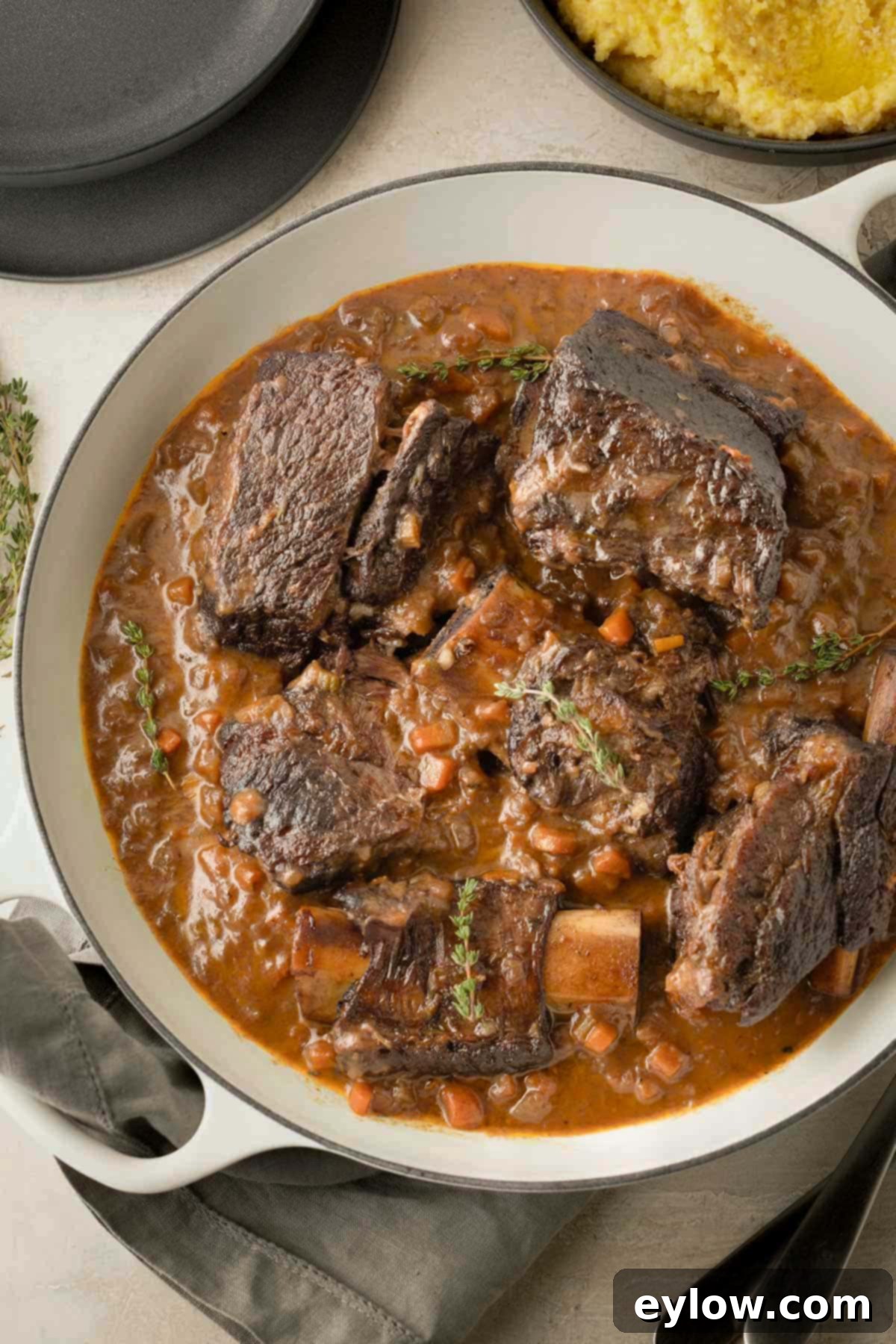
There’s a reason this recipe is a consistent favorite in my household. Every time I prepare these red wine-braised short ribs, my husband’s enthusiasm is boundless; he simply cannot stop praising their incredible flavor and succulence. Braising stands out as one of my absolute favorite slow-cooking techniques, especially for transforming tougher cuts of meat. It’s a method that promises to take something initially firm and render it into a dish so tender it quite literally melts in your mouth with every bite.
Beef short ribs, with their excellent marbling and rich connective tissue, are perfectly suited for the braising process. As they slowly cook, they absorb the deep, savory flavors of a luxurious red wine sauce, which is further infused with sweet vegetables and fragrant herbs. This creates a symphony of taste that is both complex and incredibly satisfying. This dish isn’t just a weeknight meal; it’s a truly terrific choice for any special occasion, from an intimate anniversary dinner to an elegant dinner party. Its impressive presentation and unforgettable taste make it an instant classic that guests will adore and remember long after the last bite.
[feast_advanced_jump_to]
Why You’ll Adore This Red Wine Braised Short Rib Recipe
Prepare to fall in love with these short ribs for a multitude of reasons:
- Unrivaled Tenderness: Experience beef ribs that are meltingly tender, so soft they effortlessly fall off the bone. The slow braising process breaks down tough fibers, resulting in an incredibly luxurious texture that is simply irresistible.
- Deep, Rich Flavors: Each bite bursts with complex, savory notes from the red wine, aromatic vegetables, and herbs, creating a robust and deeply satisfying flavor profile. This isn’t just good; it’s profoundly flavorful.
- Mostly Hands-Off Cooking: While the initial prep involves some steps, the majority of the cooking time is spent in the oven, allowing you to relax or attend to other tasks. It’s an ideal recipe for those who appreciate gourmet results without constant kitchen attention.
- Fantastic Make-Ahead Meal: This dish reheats exceptionally well, with flavors often deepening and improving a day or two after cooking. It’s perfect for entertaining or meal prepping, making your life easier when a busy schedule calls.
- Versatile Serving Options: These short ribs are incredibly versatile, pairing beautifully with a variety of bases. Serve them over creamy mashed potatoes, soft polenta, rich risotto, or classic egg noodles. We’ll explore more delicious serving suggestions to elevate your meal.
If you’re a fan of succulent ribs, you might also enjoy these oven-baked baby back ribs featuring a delectable Hoisin-bourbon sauce for a different but equally satisfying experience.
Essential Ingredients for Perfect Braised Short Ribs
Crafting exceptional red wine braised short ribs starts with selecting high-quality ingredients. Each component plays a vital role in building the dish’s signature depth of flavor and tender texture.

- Beef Short Ribs: For the most flavorful and tender results, always opt for bone-in beef short ribs. The bone imparts an incredible depth of flavor and moisture to the meat as it braises. Look for “English-cut” ribs, which are thick, meaty, and ideal for slow cooking. We’ll provide detailed tips below on how to select the best cuts.
- Dry Red Wine: The choice of wine is crucial for the richness of the sauce. Select a dry, full-bodied red wine that you would genuinely enjoy drinking. While it doesn’t need to be expensive, quality matters. Suggestions include Cabernet Sauvignon, Merlot, Syrah, or Malbec. Avoid overly sweet or light wines like Pinot Noir for this particular dish, as their flavors might get lost.
- Beef Broth: A high-quality beef broth is essential for a robust sauce. I highly recommend using a good quality, refrigerated or frozen beef bone broth, such as Butcher’s Broth or Bonafide. These typically offer a richer, more authentic beef flavor compared to shelf-stable cartons or bouillon cubes. Steer clear of watery or artificial-tasting pastes/bouillon.
- Onion: A fundamental aromatic, yellow, brown, or sweet onions work wonderfully. They provide a foundational sweetness and savory depth to the braising liquid as they slowly caramelize.
- Carrots: Another key component of the classic French mirepoix (the aromatic base of many sauces), carrots contribute natural sweetness and an earthy flavor that complements the beef beautifully.
- Celery: Completing the mirepoix trio, celery adds a subtle, herbaceous note and enhances the overall savory complexity of the sauce.
- Fresh Herbs: Fresh herbs are non-negotiable for their vibrant aroma and flavor. Sprigs of fresh thyme, ideally tied together for easy removal, and one or two bay leaves (either fresh or dried) will infuse the sauce with an irresistible fragrance.
- Garlic: Large, fresh garlic cloves, finely chopped, are essential for their pungent, aromatic punch. Fresh garlic provides a much brighter and more intense flavor than pre-minced varieties.
- Tomato Paste: This concentrated ingredient is a powerhouse for building umami flavor and adding a crucial touch of acidity to balance the richness of the beef and wine. It also helps in creating a beautiful deep color for the sauce.
- Olive Oil: Extra virgin olive oil is my preferred choice for browning the ribs and sautéing the vegetables, offering a pleasant fruity note. Avocado oil is another excellent neutral-tflavored option that can withstand higher heat.
- Unsalted Butter: Used at the end to create a rich, velvety finish for the sauce. Using unsalted butter allows you to control the overall saltiness of the dish.
- Flour: A small amount of all-purpose flour or a gluten-free blend is used to thicken the luxurious braising liquid into a glossy, spoonable sauce.
For precise measurements of these ingredients, along with salt and pepper, please refer to the detailed recipe card below.
If you’re short on time but craving a hearty beef dish, consider making this Instant Pot beef stew, which can be ready in just over an hour.
Chef’s Tips for Buying the Best Beef Short Ribs: Selecting the right cut of short ribs is paramount to achieving that coveted fall-off-the-bone tenderness and rich flavor. Always ask for English-cut beef short ribs. These are cut parallel to the bone, resulting in thick, meaty blocks of beef with a single bone in each piece. This is crucial; avoid “flanken-cut” ribs, which are thinner, cut across the bones, and better suited for grilling or quick cooking. When inspecting the ribs, aim for pieces that are relatively uniform in size to ensure even cooking. Each rib should ideally have at least 1 ½ inches of thick, marbled meat on the bone, with a thin, not excessive, fat cap. Good marbling—fine streaks of fat running through the meat—is a sign of quality and will render into incredible flavor and moisture during the long braise. Beware of packages containing mostly bone or “funny end pieces” with little meat; it’s happened to the best of us! For a meal serving four people generously, plan to purchase between 3 ½ to 4 pounds of these magnificent short ribs.
Flavorful Substitutions and Creative Variations
While the classic red wine braised short ribs recipe is perfect as is, you can easily adapt it to your preferences or what you have on hand. Here are some thoughtful substitutions and exciting variations to consider:
- Herbal Twist: If fresh thyme isn’t available, you can easily swap in dried thyme. Remember that dried herbs are more concentrated, so use about a third to half the amount specified for fresh (e.g., ½ to ¾ teaspoon dried thyme for 3-4 sprigs fresh). Rosemary sprigs can also be added for an earthier, more pungent aroma, pairing beautifully with beef.
- Acidity Balance: To introduce an extra layer of complexity or to finely balance the richness and acidity of the sauce at the end of cooking, stir in 1-2 tablespoons of high-quality balsamic vinegar. Its sweet and tangy notes will brighten the entire dish. A squeeze of fresh orange zest or a splash of orange juice can also provide a subtle, vibrant lift.
- Elevate with Port Wine: For an even more luxurious and complex sauce, consider incorporating a tawny port wine. Tawny port offers nutty, caramelized, and slightly sweeter flavors that beautifully complement the robust beef. Substitute about ½ cup of the dry red wine with tawny port; using it for the entire wine component might make the sauce too sweet for some palates. This combination adds an elegant depth that is truly special.
- Vegetable Additions: Feel free to add other root vegetables or hearty greens during the last hour of braising. Pearl onions, quartered cremini mushrooms, or chunks of parsnip would make wonderful additions, absorbing the rich sauce as they cook. For a touch of green, wilt in some kale or spinach towards the very end.
- Spice it Up: For a subtle warmth, a pinch of red pepper flakes or a small amount of finely minced fresh ginger can add an unexpected and delightful kick to the braising liquid.
For more comforting beef dishes, beef lovers will also appreciate this hearty beef barley vegetable soup, perfect for a cold day.
Chef’s Tip on Choosing Red Wine for Braised Short Ribs: The red wine is more than just a liquid in this recipe; it’s a foundational flavor builder. When selecting a wine for your braised short ribs, the key is to choose a dry, full-bodied red that can stand up to the richness of the meat and the intensity of the long cooking process. Excellent choices include Cabernet Sauvignon, Merlot, Syrah (also known as Shiraz), Malbec, or a robust red blend. These varietals offer the deep fruit, tannic structure, and savory undertones necessary to create a truly spectacular sauce. While we adore Pinot Noir for drinking, most Pinot Noirs tend to be a bit too light and delicate for this particular dish; their nuanced flavors might dissipate during the extensive cooking time. Importantly, the wine doesn’t need to be expensive. A moderately priced bottle, one that you would genuinely enjoy drinking, is perfectly suitable. Remember, as the wine cooks down, its flavors will concentrate and intensify, so choose a wine whose taste you appreciate, as that essence will become the soul of your sauce.
Step-by-Step Guide to Braising Short Ribs
Let’s walk through the process of creating these magnificent red wine braised short ribs. Precision in each step contributes to the ultimate tenderness and flavor.
Selecting the Right Pot for Braising
The vessel you choose for braising plays a significant role in the outcome of your short ribs. The ideal pot for braised short ribs is a large, heavy-bottomed Dutch oven with a tight-fitting lid, such as a Le Creuset 5 ½ quart. Cast iron, with its excellent heat retention and even distribution, is perfect for the slow, steady cooking required for braising.
I’ve also successfully prepared these red wine braised short ribs in a 3 ½ quart braiser, which is a shallower, wider pan with a domed lid. The difference in pot geometry can affect liquid evaporation. When using the braiser, I found that I desired a slightly more abundant sauce for serving. Therefore, I typically add an extra cup of broth to the pan when thickening the sauce at the end. It’s a good practice to eye the sauce quantity once the ribs are done braising and adjust according to your preference. In my experience with the braiser, I usually yield about 3 cups of finished sauce, which is a good amount.
Conversely, when making the ribs in a deeper Dutch oven, additional broth is rarely needed. The smaller surface area and tighter fit of the ribs in the pot mean less liquid evaporates during the braising process, resulting in a naturally reduced and concentrated sauce without further additions.
The Braising Process: A Detailed Walkthrough
Begin by pre-heating your oven to 325°F (160°C). Before you place your pot in the oven, double-check that it fits comfortably with the lid on. You might need to adjust or temporarily remove a top oven rack to ensure there’s enough clearance.

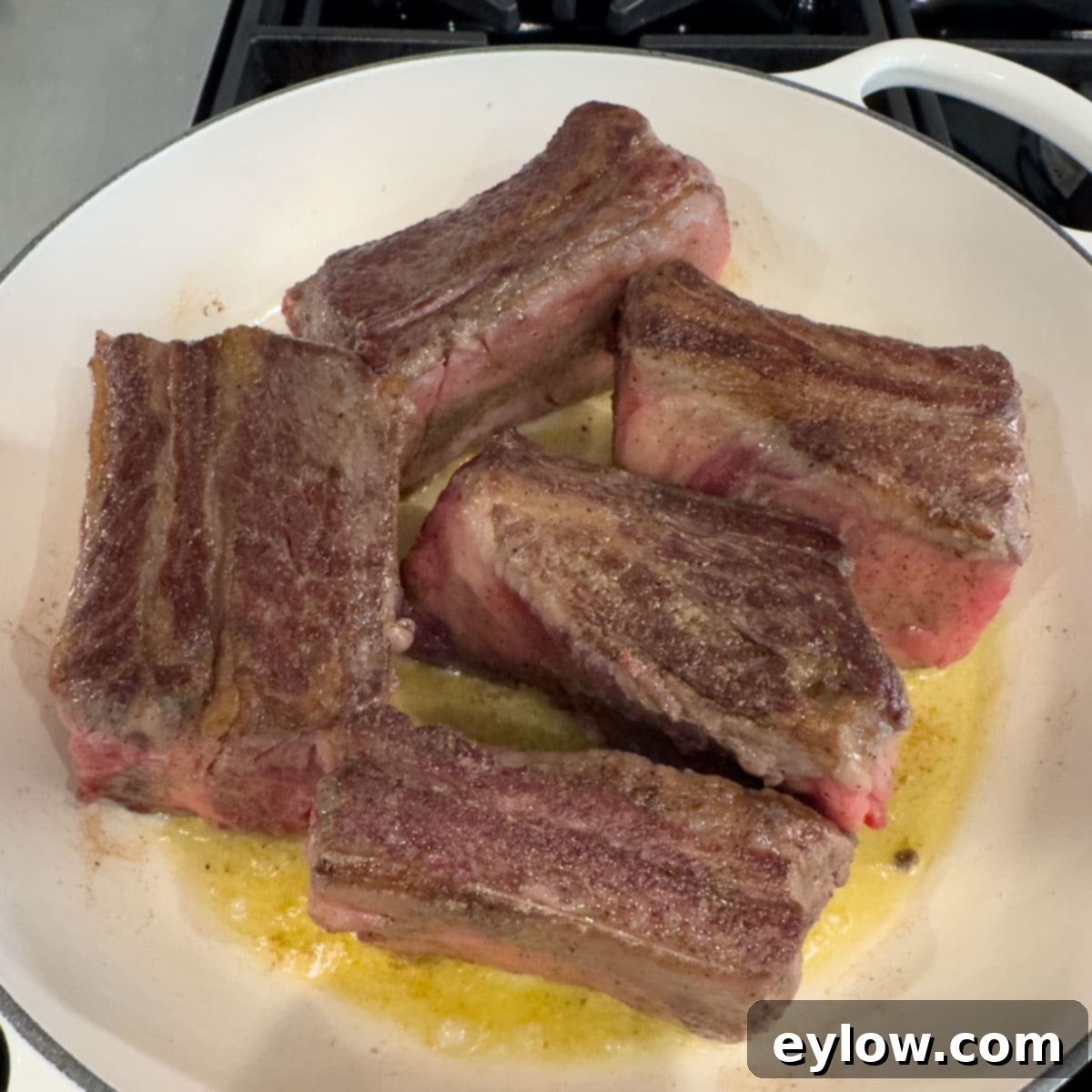
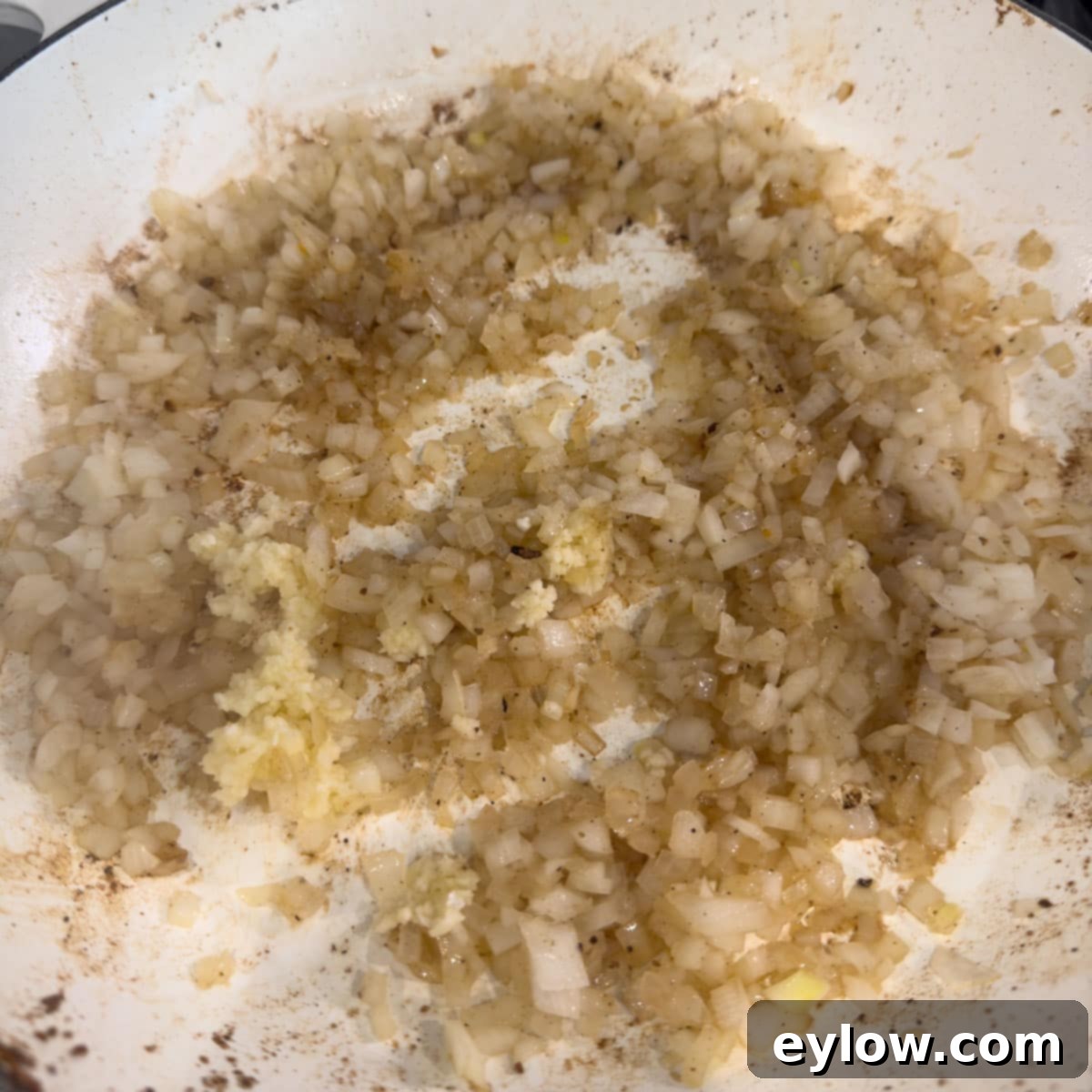
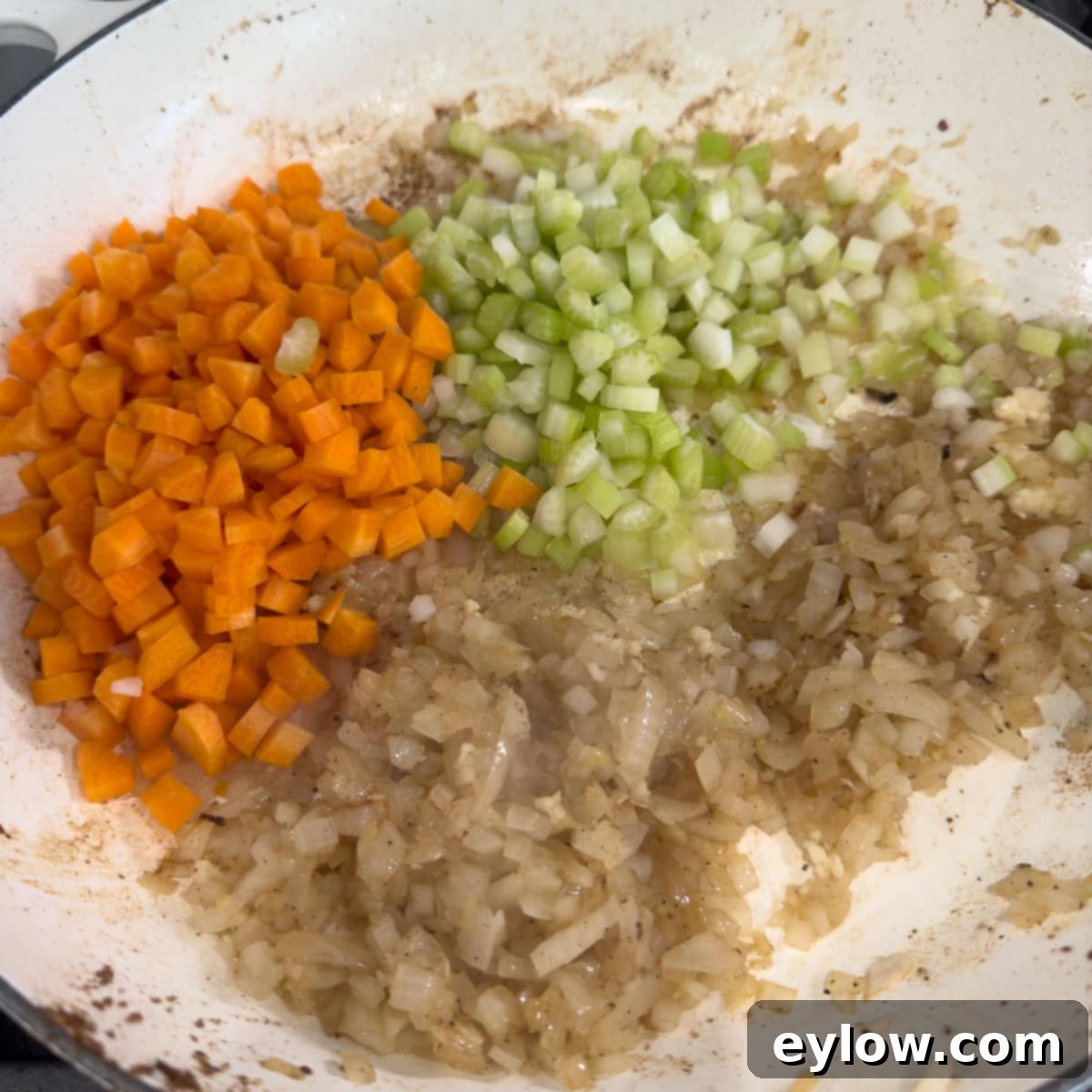
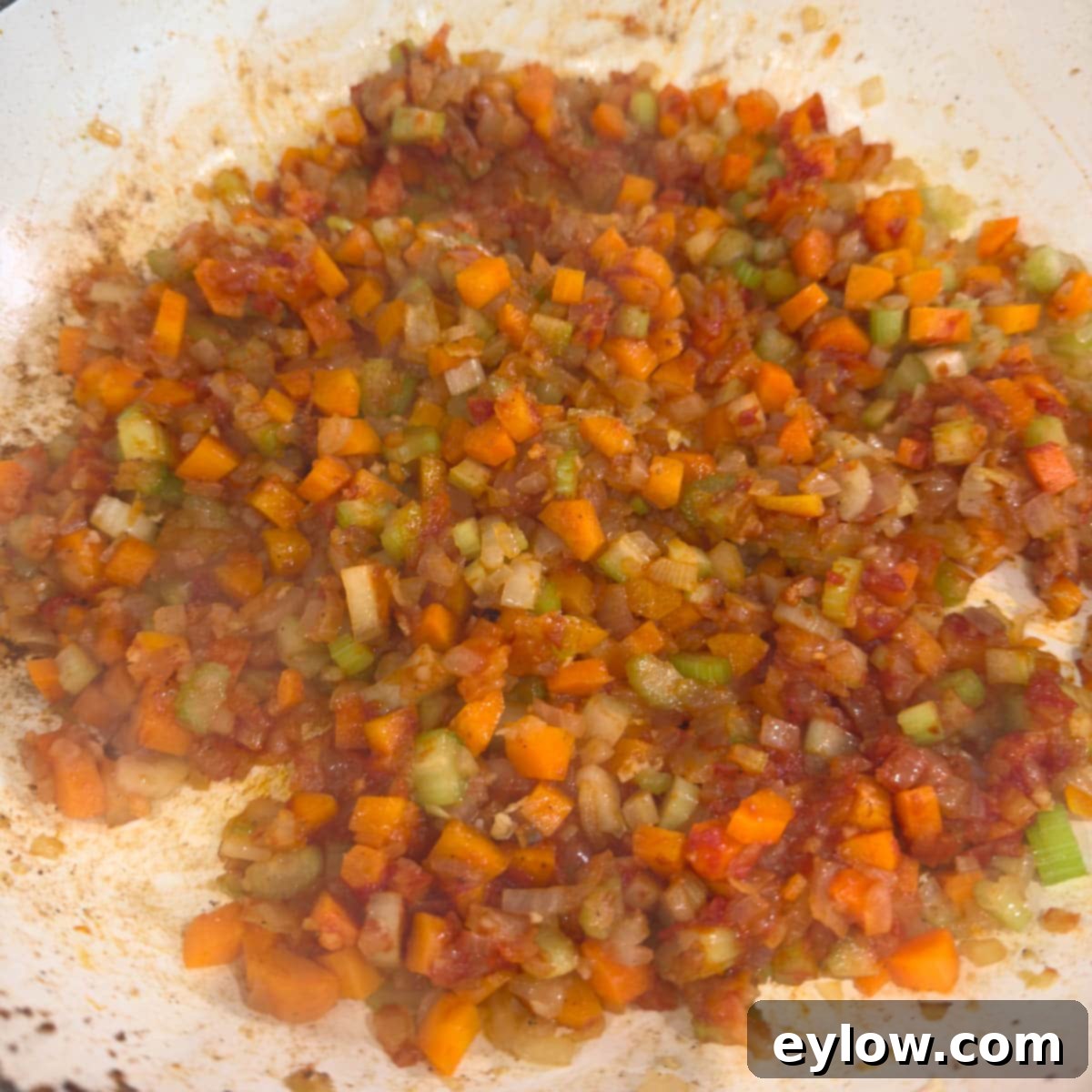

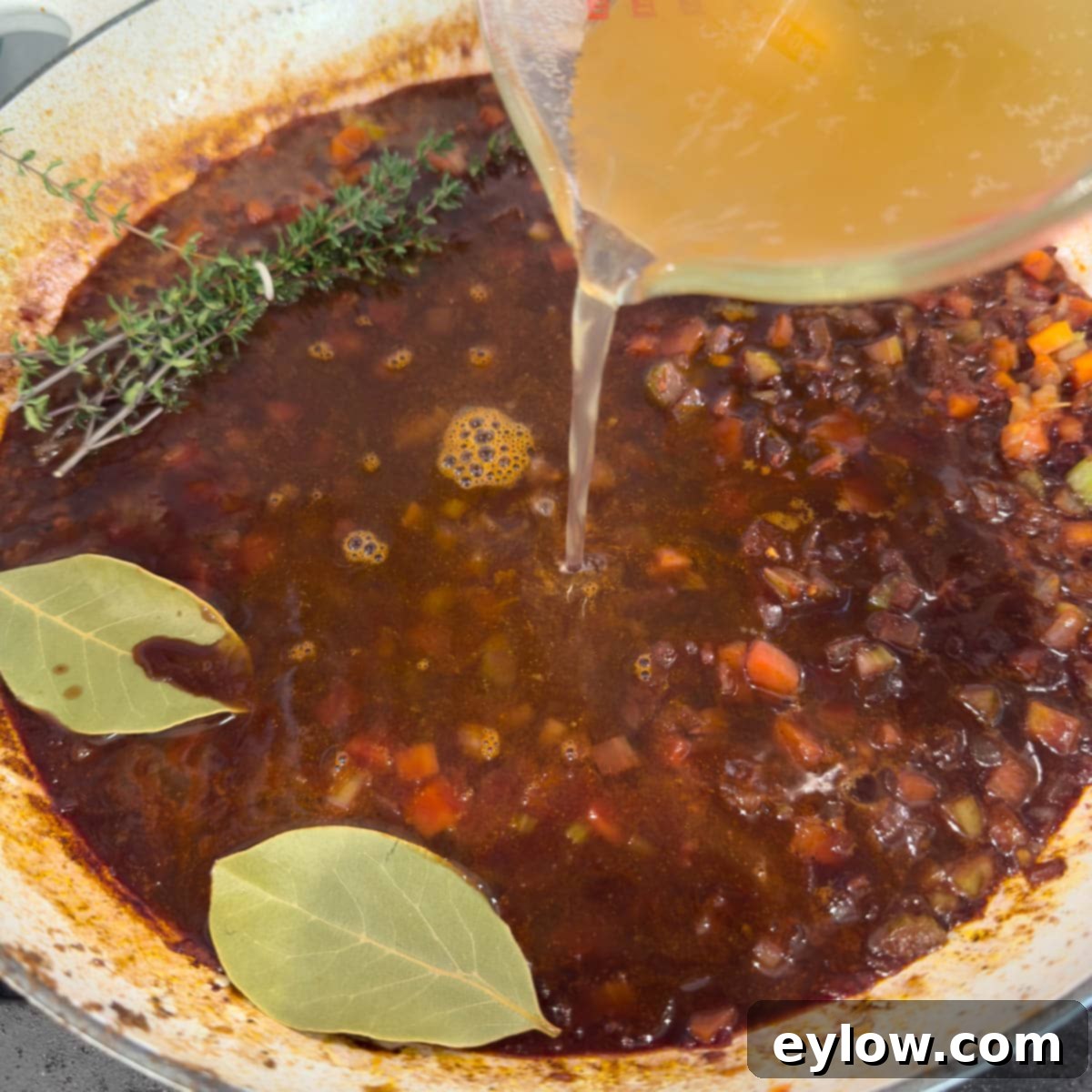
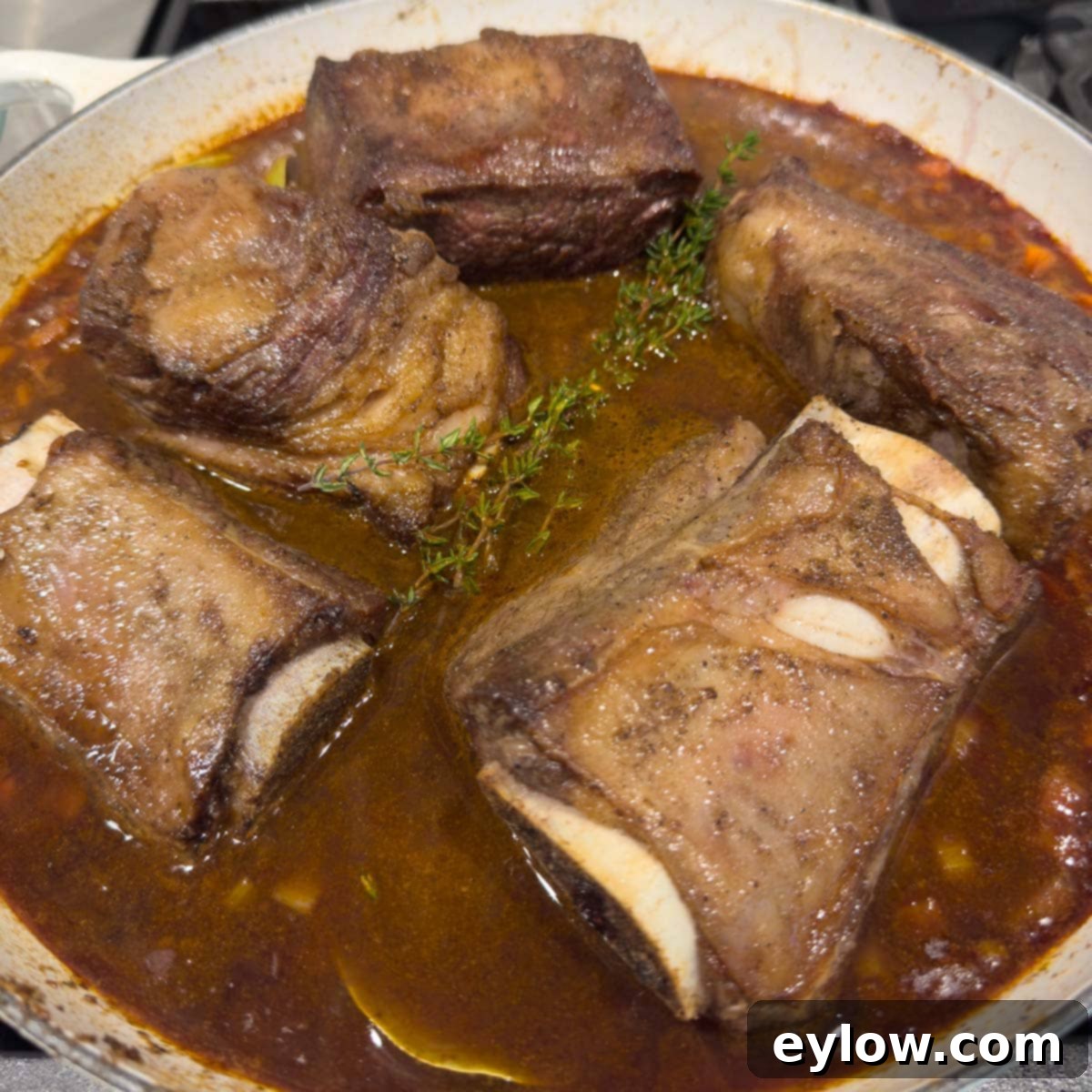


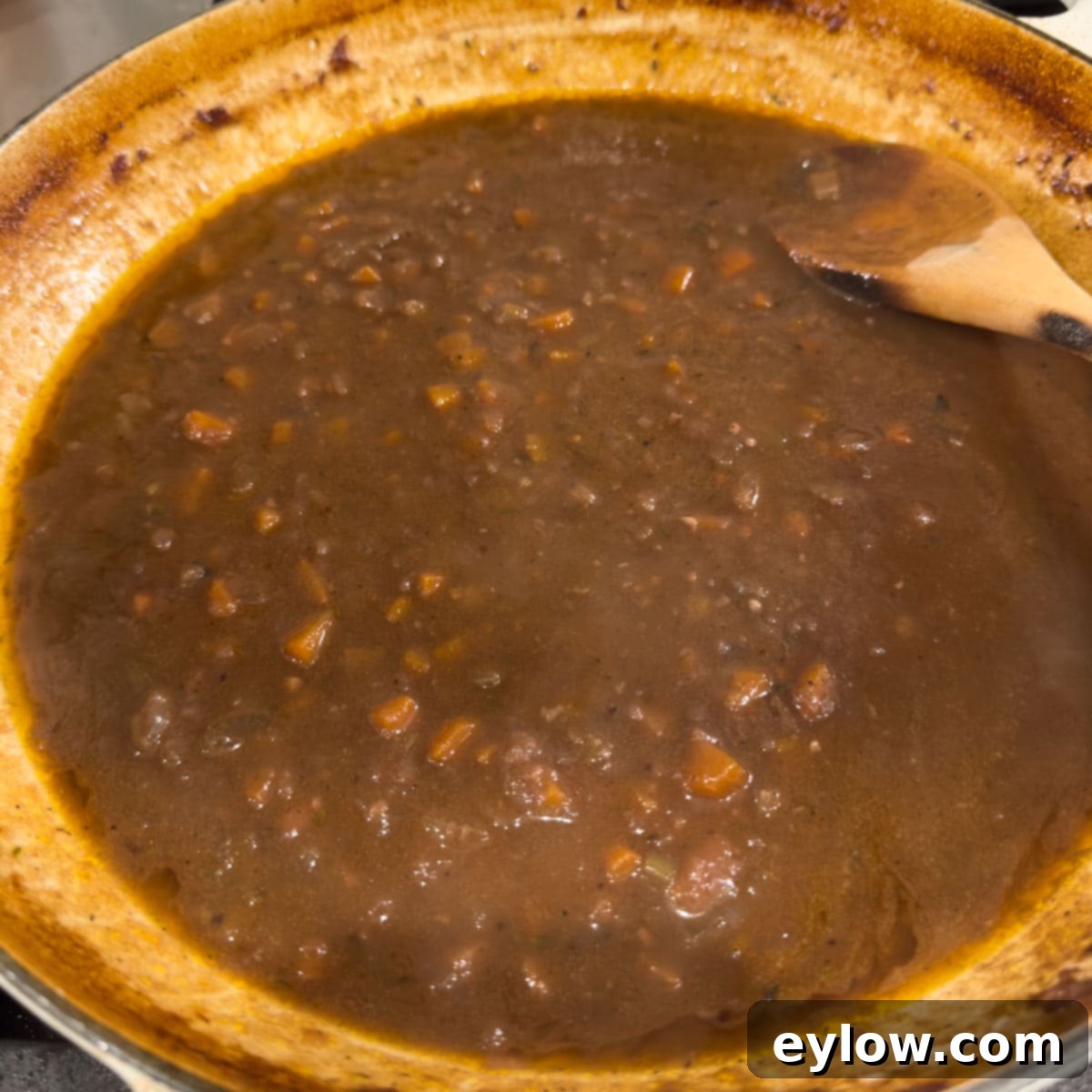
Chef’s Tip for Thickening the Sauce: The Beurre Manié Secret
Forget cornstarch for a truly authentic, silky sauce. Instead, employ a classic French technique called a “beurre manié” (pronounced ‘burr man-ay’), which translates to “kneaded butter.” This professional trick results in a much richer, smoother, and more stable sauce. To make it, simply create a smooth paste by thoroughly mixing equal amounts of room-temperature unsalted butter and all-purpose or gluten-free flour. Just a tablespoon of each will be sufficient to thicken your luxurious short rib sauce. Once formed, drop the beurre manié into your simmering pot or pan of sauce and whisk continuously until it dissolves and the sauce thickens to your desired consistency. Continue to cook for a minute or two to ensure any raw flour taste is gone. This method provides an incredible richness and velvety texture that elevates your sauce to gourmet status.
Making Red Wine Braised Short Ribs Ahead of Time
One of the many virtues of braised beef short ribs is their exceptional ability to be made ahead of time. In fact, many chefs agree that the flavors deepen and meld even more harmoniously after a day or two in the refrigerator. This makes them an ideal dish for entertaining or for preparing a delicious meal without last-minute stress. You can easily prepare these ribs a day or two in advance.
To reheat, simply place the short ribs and their sauce back into a Dutch oven or heavy-bottomed pot. Gently warm them on the stovetop over low heat with the lid on, or in the oven at a moderate temperature (around 325°F / 160°C) until they are heated through to an internal temperature of 165°F (74°C). Keep in mind that if the pot is cold straight from the refrigerator, it will take a considerable amount of time to heat evenly, so plan accordingly. For best results and quicker reheating, take the ribs out of the refrigerator about an hour before you plan to reheat them, allowing them to come closer to room temperature and gently take the chill off.
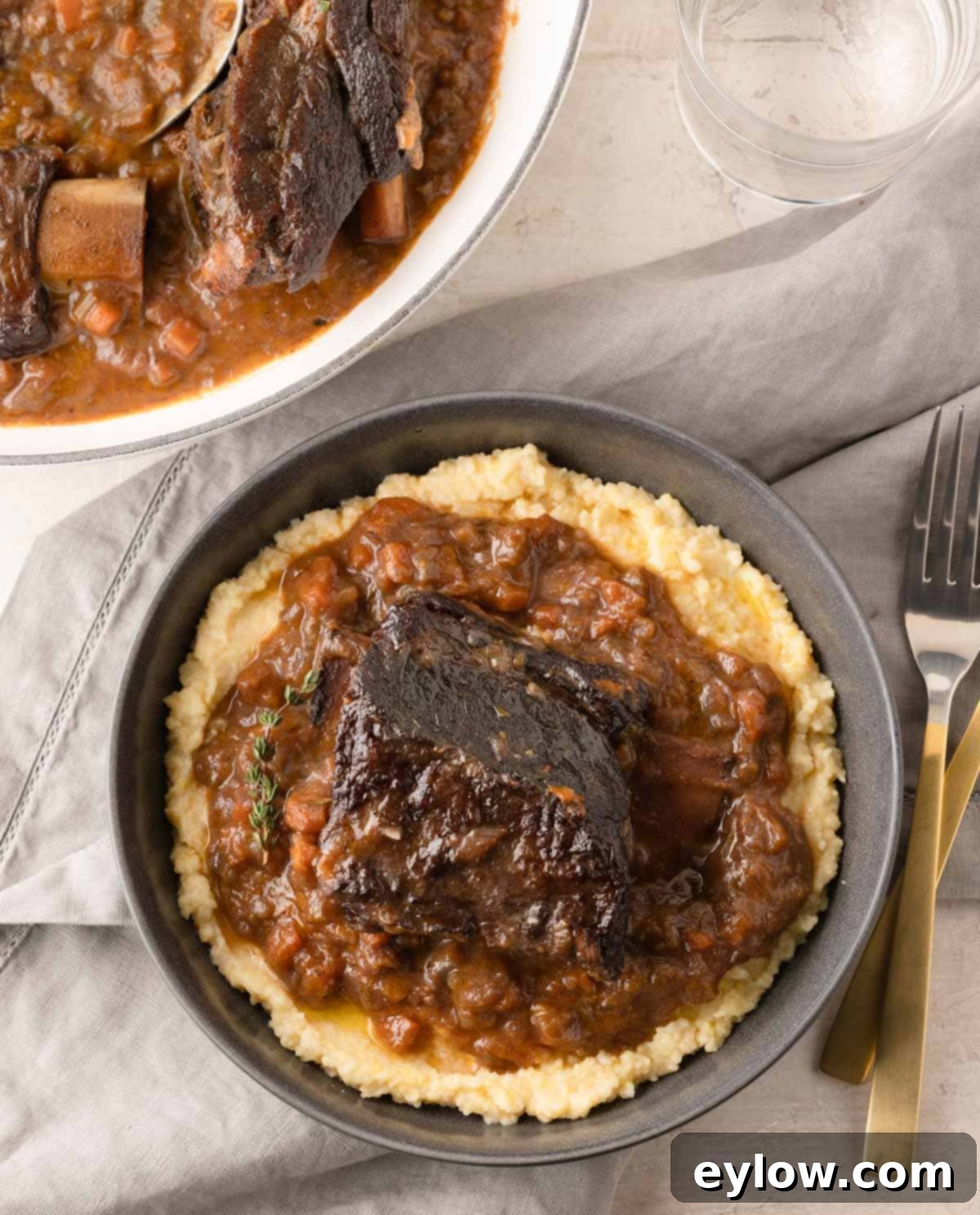
Inspired Serving Suggestions
The beauty of red wine braised short ribs lies not only in their incredible flavor but also in their versatility. They are truly delicious served in a shallow bowl, allowing ample room for that magnificent, rich sauce to be spooned generously over your chosen base:
- Creamy Mashed Potatoes: The ultimate classic pairing. Their smooth, buttery texture provides a perfect canvas for the savory sauce. Consider riced mashed potatoes for an exceptionally light and fluffy result.
- Cauliflower Puree: For a lighter, low-carb alternative that still offers creamy indulgence, a velvety cauliflower puree is an excellent choice.
- Creamy Polenta: This soft, comforting cornmeal porridge is a traditional Italian accompaniment that beautifully soaks up every drop of the rich sauce.
- Risotto: A creamy mushroom or Parmesan risotto would add another layer of sophistication and texture.
- Egg Noodles or Pasta: Simple wide egg noodles or a hearty pasta like pappardelle or tagliatelle are fantastic for catching and holding the thick sauce.
To complete your fantastic dinner, add a simple, vibrant tossed green side salad. A light dressing, such as a honey-balsamic vinaigrette, will cut through the richness of the short ribs and cleanse the palate. The fresh, tangy flavors pair wonderfully with the deep, savory notes of the main dish.
Another delightful option for serving red wine braised short ribs is to completely shred all the tender meat off the bone and mix it directly with the sauce. This makes an incredible ragu-like topping for pasta, creating an unbelievably satisfying and hearty pasta dish. It’s a fantastic way to stretch the meal or present it in a different, equally impressive format.
Leftover Inspiration: Don’t let a single bit of these wine-braised beef short ribs go to waste. They make truly terrific leftovers! Shred the meat and transform it into gourmet tacos with your favorite toppings for a unique twist. Toss the shredded meat with buttered egg noodles for a quick and comforting meal, or add it to a pot of vegetable soup for an instant flavor boost.
And absolutely, positively, do not discard that extra sauce! It’s liquid gold. Store it separately and freeze it in individual portions. It can be thawed and served over plain pasta, rice, or polenta for a quick meal, or used to enrich a pot of homemade marinara sauce, adding incredible depth to future dishes.
Proper Storage and Freezing Instructions
Ensuring your delicious braised beef short ribs remain fresh and flavorful is simple with proper storage techniques. Whether you plan to enjoy them in a few days or save them for a future meal, these guidelines will help.
Cooked braised beef short ribs, along with any leftover sauce, should be stored in an airtight container in the refrigerator. They will maintain their quality and freshness for 3-4 days. When refrigerating, ensure the ribs are as covered by the sauce as possible, as this helps prevent them from drying out.
How to Freeze Short Ribs for Future Enjoyment
Freezing braised short ribs is an excellent way to preserve their incredible flavor and tenderness for longer periods. Follow these steps for optimal freezing:
- Cool Completely: Before freezing, allow the short ribs and sauce to cool down to room temperature. Freezing hot food can lower the temperature of your freezer and potentially affect other frozen items.
- Portion for Convenience: Divide the short ribs into individual servings or meal-sized portions. This makes thawing and reheating much easier, as you only take out what you need. Include a generous amount of sauce with each portion.
- Use Airtight Containers: Transfer the cooled short ribs and sauce into freezer-safe, airtight containers or heavy-duty freezer bags. Removing as much air as possible (e.g., by pressing air out of freezer bags) is key to preventing freezer burn, which can compromise texture and flavor.
- Label and Date: Always label your containers or bags with the name of the dish (“Red Wine Braised Short Ribs”) and the date it was prepared. This helps you keep track of your frozen inventory and ensures you use them within an optimal timeframe (typically up to 3 months for best quality).
For the best possible freezing results, make sure the ribs are mostly submerged in the rich sauce. This acts as a protective layer, keeping the meat moist and shielded from freezer burn. When you’re ready to enjoy them, thaw the frozen short ribs overnight in the refrigerator.
To reheat, place the thawed ribs and sauce in a covered pot on the stovetop over low heat, or in an oven preheated to 350°F (175°C). Reheat gently until the meat is thoroughly warmed through to an internal temperature of 165°F (74°C). Avoid high heat, as this can cause the meat to toughen.

Frequently Asked Questions About Braised Short Ribs
The absolute best cut for braised short ribs is the bone-in English-cut beef short rib. This specific cut, derived from the chuck section of the cow, features thick, meaty portions with a single bone in each. The bone is crucial as it imparts exceptional flavor, gelatin, and moisture to the meat and the overall braising liquid, resulting in a richer, more tender final dish. Look for ribs with good marbling (streaks of fat) for optimal flavor and succulence.
Preventing dry ribs is key to achieving that signature tenderness. The most important factor is to ensure there’s always an adequate amount of braising liquid in the pot while cooking. The liquid should come approximately halfway up the sides of the ribs, or even a little higher, but not completely cover them. This creates a moist, steamy environment while allowing the top portion to develop a flavorful crust. Periodically check the pot during the braising process (especially after the first 1.5 hours), and if the liquid level appears too low, add more beef broth (or water in a pinch) to maintain the proper level. Following this simple tip will guarantee you consistently juicy, tender, and succulent short ribs every time.
If, after cooking, the wine flavor in your sauce seems too strong or overly acidic, there are several ways to balance it. You can stir in a little unsalted butter at the end; its richness will help to round out and mellow the sharp edges of the wine. Adding a small amount (1-2 tablespoons) of good quality balsamic vinegar can actually help balance acidity by adding a touch of complex sweetness. A tiny bit of honey or maple syrup can introduce sweetness to counteract the tartness. Alternatively, you can dilute the sauce slightly by adding a splash more beef broth, water, or even a touch of cream (if suitable for your dish) to mellow the wine’s intensity without sacrificing flavor.
No, there is generally no need to turn the ribs over during the braising process. Braising is a moist-heat cooking method where the ribs are submerged in liquid and cooked slowly in a covered pot. The steam and circulating heat within the confined environment of your Dutch oven create an incredibly even cooking environment. This ensures that the ribs will cook uniformly, becoming equally tender on all sides without the need for flipping. This hands-off approach is part of what makes braising such a rewarding and relatively low-effort cooking method.
More Richly Flavored Recipes to Savor
If you have a passion for deeply flavored sauces and comforting, savory dishes, then these recipes are sure to become new favorites in your kitchen. Each one promises a burst of rich, satisfying taste.
- How to Make Meatball Beef Stroganoff
- Roast Pork Tenderloin with Dijon Mustard Sauce
- One Pan Italian Chicken Thighs
- Sour Cream Pork Chops Recipe
Did You Make This Delicious Recipe?
If you’ve taken the plunge and made these incredible red wine braised short ribs, I would absolutely love to hear about your experience! Your feedback is invaluable, and I truly enjoy connecting with readers who have tried my recipes. Please take a moment to add your comment below. If you loved them as much as we do, please consider leaving a 5-star rating! Your ratings help other aspiring cooks discover and enjoy this wonderful dish.
📖 Recipe

Red Wine Braised Short Ribs
Sally Cameron
Pin Recipe
Equipment
-
Large dutch oven with lid 5 ½ quarts
-
3 quart braiser with lid alternative pan
Ingredients
- 1 tablespoon olive oil
- 3 ½-4 pounds bone-in beef short ribs English cut
- 1 teaspoon sea salt
- ½ teaspoon ground black pepper
- 1 medium onion about 1 ½ cups chopped
- 2-3 carrots ¾ cup chopped
- 2-3 ribs celery ¾ cup chopped
- 3 large garlic cloves chopped fine
- 2 tablespoons tomato paste
- 1 ½ cups dry red wine
- 3-4 sprigs fresh thyme
- 2 bay leaves fresh or dried
- 2-3 cups beef bone broth
- 1 tablespoon unsalted butter at room temperature
- 1 tablespoon flour gluten-free blend or all purpose
Instructions
Brown and sear the ribs
-
Pre-heat the oven to 325°F (160°C). Make sure to check that your chosen pot fits inside the oven with its lid securely on; you might need to adjust or temporarily remove a top oven rack.
Pat the beef short ribs thoroughly dry with paper towels. This crucial step ensures a superior sear and a beautiful brown crust, which is essential for developing deep flavors. Season all sides of the ribs generously with sea salt and freshly ground black pepper. Heat the olive oil in your 5 ½-quart Dutch oven or other heavy-bottomed braising pot over medium-high heat until it shimmers. Carefully add the seasoned beef ribs to the hot oil, ensuring not to overcrowd the pan (you may need to work in batches). Brown the ribs on all sides, turning them periodically, for a total of 12-13 minutes, until they develop a rich, deep golden-brown crust. This browning step is vital for building complex flavors. Once browned, transfer the ribs to a large plate or bowl and set aside.
Cook the vegetables and aromatics
-
Carefully pour out all but approximately 1 tablespoon of the rendered fat from the pot. Reduce the heat to medium to medium-low. Add the chopped onions to the remaining fat and sauté, stirring occasionally, until they are soft and translucent, which should take about 3-4 minutes. Next, add the finely chopped garlic and cook for just 1 minute longer, allowing its aroma to become fragrant without burning. Finally, add the chopped carrots and celery to the pot. Stir to combine with the onions and garlic, and cook until these vegetables begin to soften, approximately another 3-4 minutes. This vegetable base forms the aromatic foundation of your braising liquid.
Make the braising liquid
-
Stir in the tomato paste, ensuring it gets a chance to cook directly on the bottom of the pan for about 2 minutes. This step helps to deepen its flavor and mellow its raw acidity. Next, pour in the dry red wine to deglaze the pan. Turn up the heat slightly and bring the wine to a simmer, allowing it to reduce by half its volume. This concentration of wine flavors is crucial and should take about 5-7 minutes. Make sure to scrape up any flavorful browned bits from the bottom of the pan as the wine reduces.
Add the beef broth to the pot, along with the fresh thyme sprigs (ideally tied together with kitchen twine for easy removal) and the bay leaves. Bring the liquid to a gentle simmer. Carefully nestle the previously browned short ribs back into the sauce. The liquid should come up about halfway to two-thirds up the sides of the ribs, ensuring they braise beautifully without being completely submerged.
Braise the ribs
-
Place the lid securely on the pot and transfer it to your pre-heated 325°F (160°C) oven. Braise for 2 ½ hours. About halfway through the braising time (after approximately 1 ½ hours), briefly check the broth level to ensure there is enough liquid. The liquid should still come about halfway up the sides of the ribs. If it has reduced significantly, add a little extra beef broth (or water if you’ve run out) to maintain the optimal level. In most cases, I find that I do not need to add more.
Important Note: There is absolutely no need to turn the ribs during the braising process. The moist heat and steam within the covered pot ensure they cook evenly and become incredibly tender on all sides.
Finish the ribs
-
Once the braising time is complete and the ribs are fall-off-the-bone tender, carefully remove the pot from the oven. Transfer the succulent ribs to a separate plate and tent loosely with foil to keep them warm while you finish the sauce. Skim off any excess fat that has risen to the top of the braising liquid using a spoon or a fat separator, then discard it. To thicken the sauce to a luxurious consistency, prepare a beurre manié: mash the room-temperature unsalted butter and flour together until you have a smooth paste.
Return the pot with the sauce to the stovetop and bring it to a gentle simmer over medium heat. Drop in the beurre manié paste and whisk continuously until it dissolves and the sauce begins to thicken. Cook for about 2 minutes, stirring constantly, to ensure any raw flour taste is cooked out and the sauce reaches a glossy, velvety texture. Once the sauce is perfectly thickened, it’s ready to serve. Return the warm ribs to the pot, coat them generously with the rich sauce, and serve immediately with your favorite accompaniments.
Notes
Wine Recommendation: For the best flavor in your braised short ribs, choose a dry, full-bodied red wine. Excellent options include Cabernet Sauvignon, Merlot, Syrah (Shiraz), or a red blend. The wine doesn’t need to be expensive; select one that you would genuinely enjoy drinking, as its flavors will concentrate and deepen during the cooking process.
Pots and Pans Note: If you opt to use a braiser (a wider, shallower pan) instead of a deeper Dutch oven, be aware that there may be increased evaporation of the sauce during cooking due to the larger surface area. To account for this, it’s advisable to check the broth level after approximately 1 ½ hours of braising. Ensure the liquid still comes about halfway up the sides of the ribs; if it’s too low, add a bit more broth to prevent the ribs from drying out and to maintain a sufficient amount of sauce.
